Edwin Simpson
How well can LLMs Grade Essays in Arabic?
Jan 27, 2025Abstract:This research assesses the effectiveness of state-of-the-art large language models (LLMs), including ChatGPT, Llama, Aya, Jais, and ACEGPT, in the task of Arabic automated essay scoring (AES) using the AR-AES dataset. It explores various evaluation methodologies, including zero-shot, few-shot in-context learning, and fine-tuning, and examines the influence of instruction-following capabilities through the inclusion of marking guidelines within the prompts. A mixed-language prompting strategy, integrating English prompts with Arabic content, was implemented to improve model comprehension and performance. Among the models tested, ACEGPT demonstrated the strongest performance across the dataset, achieving a Quadratic Weighted Kappa (QWK) of 0.67, but was outperformed by a smaller BERT-based model with a QWK of 0.88. The study identifies challenges faced by LLMs in processing Arabic, including tokenization complexities and higher computational demands. Performance variation across different courses underscores the need for adaptive models capable of handling diverse assessment formats and highlights the positive impact of effective prompt engineering on improving LLM outputs. To the best of our knowledge, this study is the first to empirically evaluate the performance of multiple generative Large Language Models (LLMs) on Arabic essays using authentic student data.
Out-of-Distribution Detection with Attention Head Masking for Multimodal Document Classification
Aug 20, 2024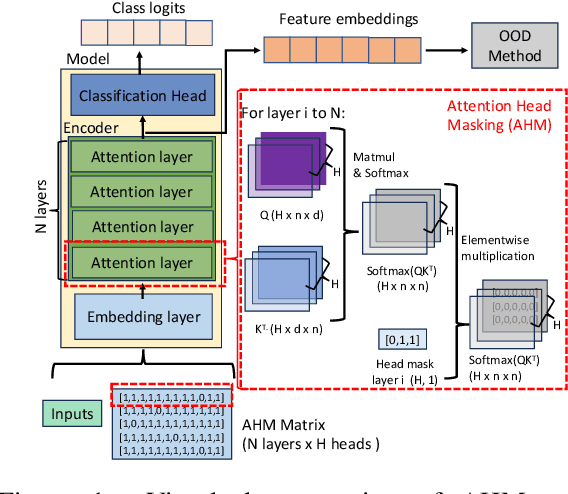

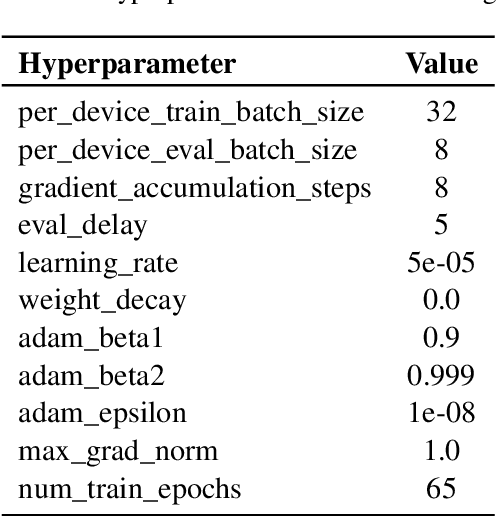

Abstract:Detecting out-of-distribution (OOD) data is crucial in machine learning applications to mitigate the risk of model overconfidence, thereby enhancing the reliability and safety of deployed systems. The majority of existing OOD detection methods predominantly address uni-modal inputs, such as images or texts. In the context of multi-modal documents, there is a notable lack of extensive research on the performance of these methods, which have primarily been developed with a focus on computer vision tasks. We propose a novel methodology termed as attention head masking (AHM) for multi-modal OOD tasks in document classification systems. Our empirical results demonstrate that the proposed AHM method outperforms all state-of-the-art approaches and significantly decreases the false positive rate (FPR) compared to existing solutions up to 7.5\%. This methodology generalizes well to multi-modal data, such as documents, where visual and textual information are modeled under the same Transformer architecture. To address the scarcity of high-quality publicly available document datasets and encourage further research on OOD detection for documents, we introduce FinanceDocs, a new document AI dataset. Our code and dataset are publicly available.
Automated essay scoring in Arabic: a dataset and analysis of a BERT-based system
Jul 15, 2024Abstract:Automated Essay Scoring (AES) holds significant promise in the field of education, helping educators to mark larger volumes of essays and provide timely feedback. However, Arabic AES research has been limited by the lack of publicly available essay data. This study introduces AR-AES, an Arabic AES benchmark dataset comprising 2046 undergraduate essays, including gender information, scores, and transparent rubric-based evaluation guidelines, providing comprehensive insights into the scoring process. These essays come from four diverse courses, covering both traditional and online exams. Additionally, we pioneer the use of AraBERT for AES, exploring its performance on different question types. We find encouraging results, particularly for Environmental Chemistry and source-dependent essay questions. For the first time, we examine the scale of errors made by a BERT-based AES system, observing that 96.15 percent of the errors are within one point of the first human marker's prediction, on a scale of one to five, with 79.49 percent of predictions matching exactly. In contrast, additional human markers did not exceed 30 percent exact matches with the first marker, with 62.9 percent within one mark. These findings highlight the subjectivity inherent in essay grading, and underscore the potential for current AES technology to assist human markers to grade consistently across large classes.
Automated Radiology Report Generation: A Review of Recent Advances
May 17, 2024Abstract:Increasing demands on medical imaging departments are taking a toll on the radiologist's ability to deliver timely and accurate reports. Recent technological advances in artificial intelligence have demonstrated great potential for automatic radiology report generation (ARRG), sparking an explosion of research. This survey paper conducts a methodological review of contemporary ARRG approaches by way of (i) assessing datasets based on characteristics, such as availability, size, and adoption rate, (ii) examining deep learning training methods, such as contrastive learning and reinforcement learning, (iii) exploring state-of-the-art model architectures, including variations of CNN and transformer models, (iv) outlining techniques integrating clinical knowledge through multimodal inputs and knowledge graphs, and (v) scrutinising current model evaluation techniques, including commonly applied NLP metrics and qualitative clinical reviews. Furthermore, the quantitative results of the reviewed models are analysed, where the top performing models are examined to seek further insights. Finally, potential new directions are highlighted, with the adoption of additional datasets from other radiological modalities and improved evaluation methods predicted as important areas of future development.
Interactively Learning to Summarise Timelines by Reinforcement Learning
Nov 14, 2022



Abstract:Timeline summarisation (TLS) aims to create a time-ordered summary list concisely describing a series of events with corresponding dates. This differs from general summarisation tasks because it requires the method to capture temporal information besides the main idea of the input documents. This paper proposes a TLS system which can interactively learn from the user's feedback via reinforcement learning and generate timelines satisfying the user's interests. We define a compound reward function that can update automatically according to the received feedback through interaction with the user. The system utilises the reward function to fine-tune an abstractive summarisation model via reinforcement learning to guarantee topical coherence, factual consistency and linguistic fluency of the generated summaries. The proposed system avoids the need of preference feedback from individual users. The experiments show that our system outperforms the baseline on the benchmark TLS dataset and can generate accurate and timeline precises that better satisfy real users.
Ranking Scientific Papers Using Preference Learning
Sep 02, 2021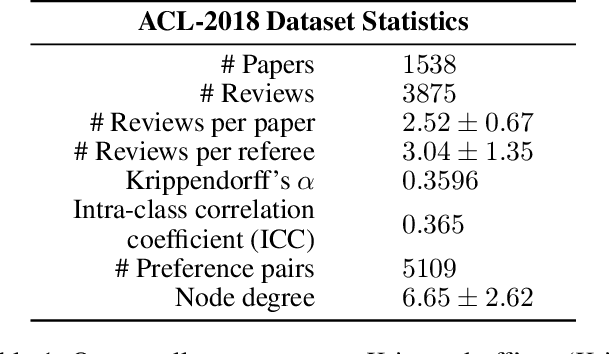
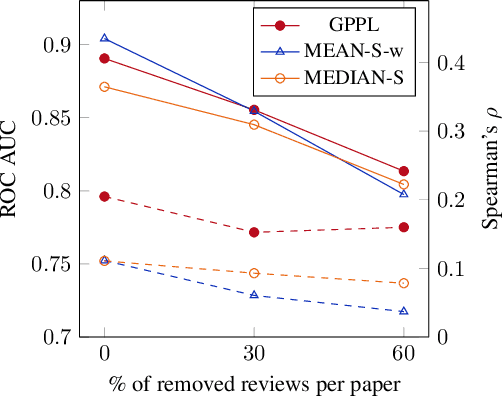


Abstract:Peer review is the main quality control mechanism in academia. Quality of scientific work has many dimensions; coupled with the subjective nature of the reviewing task, this makes final decision making based on the reviews and scores therein very difficult and time-consuming. To assist with this important task, we cast it as a paper ranking problem based on peer review texts and reviewer scores. We introduce a novel, multi-faceted generic evaluation framework for making final decisions based on peer reviews that takes into account effectiveness, efficiency and fairness of the evaluated system. We propose a novel approach to paper ranking based on Gaussian Process Preference Learning (GPPL) and evaluate it on peer review data from the ACL-2018 conference. Our experiments demonstrate the superiority of our GPPL-based approach over prior work, while highlighting the importance of using both texts and review scores for paper ranking during peer review aggregation.
Ranking Creative Language Characteristics in Small Data Scenarios
Oct 23, 2020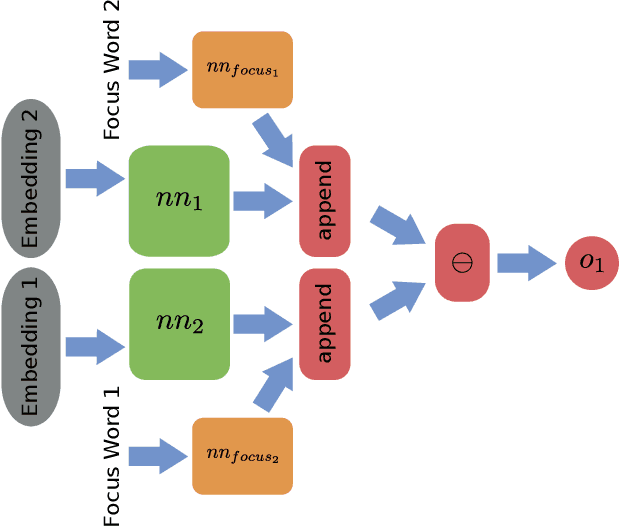
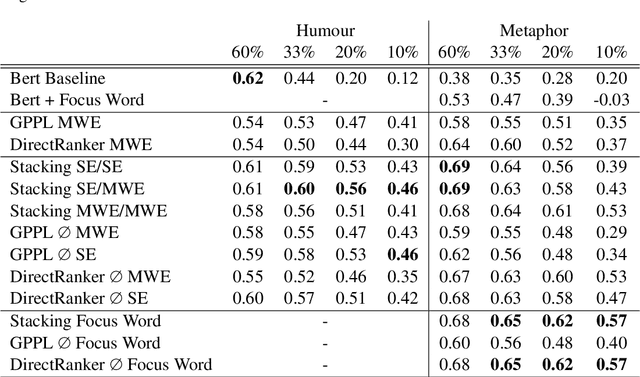

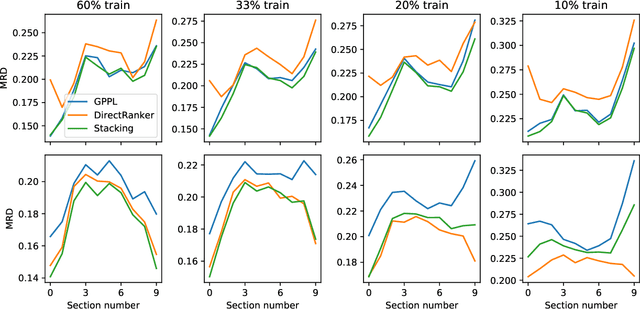
Abstract:The ability to rank creative natural language provides an important general tool for downstream language understanding and generation. However, current deep ranking models require substantial amounts of labeled data that are difficult and expensive to obtain for different domains, languages and creative characteristics. A recent neural approach, the DirectRanker, promises to reduce the amount of training data needed but its application to text isn't fully explored. We therefore adapt the DirectRanker to provide a new deep model for ranking creative language with small data. We compare DirectRanker with a Bayesian approach, Gaussian process preference learning (GPPL), which has previously been shown to work well with sparse data. Our experiments with sparse training data show that while the performance of standard neural ranking approaches collapses with small training datasets, DirectRanker remains effective. We find that combining DirectRanker with GPPL increases performance across different settings by leveraging the complementary benefits of both models. Our combined approach outperforms the previous state-of-the-art on humor and metaphor novelty tasks, increasing Spearman's $\rho$ by 14% and 16% on average.
OFAI-UKP at HAHA@IberLEF2019: Predicting the Humorousness of Tweets Using Gaussian Process Preference Learning
Aug 03, 2020
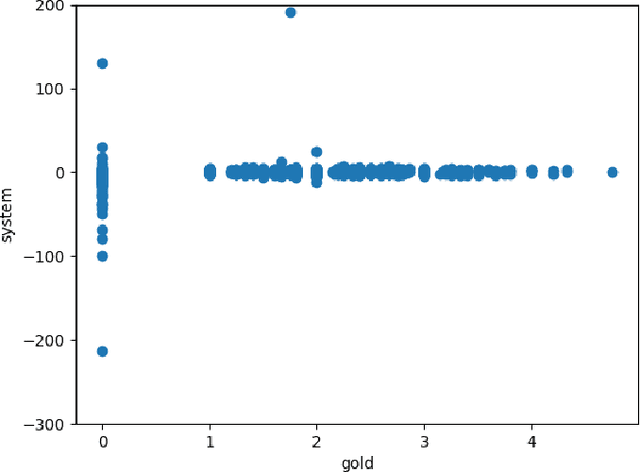
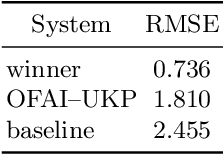
Abstract:Most humour processing systems to date make at best discrete, coarse-grained distinctions between the comical and the conventional, yet such notions are better conceptualized as a broad spectrum. In this paper, we present a probabilistic approach, a variant of Gaussian process preference learning (GPPL), that learns to rank and rate the humorousness of short texts by exploiting human preference judgments and automatically sourced linguistic annotations. We apply our system, which had previously shown good performance on English-language one-liners annotated with pairwise humorousness annotations, to the Spanish-language data set of the HAHA@IberLEF2019 evaluation campaign. We report system performance for the campaign's two subtasks, humour detection and funniness score prediction, and discuss some issues arising from the conversion between the numeric scores used in the HAHA@IberLEF2019 data and the pairwise judgment annotations required for our method.
* 11 pages, 1 figure
Low Resource Multi-Task Sequence Tagging -- Revisiting Dynamic Conditional Random Fields
May 01, 2020



Abstract:We compare different models for low resource multi-task sequence tagging that leverage dependencies between label sequences for different tasks. Our analysis is aimed at datasets where each example has labels for multiple tasks. Current approaches use either a separate model for each task or standard multi-task learning to learn shared feature representations. However, these approaches ignore correlations between label sequences, which can provide important information in settings with small training datasets. To analyze which scenarios can profit from modeling dependencies between labels in different tasks, we revisit dynamic conditional random fields (CRFs) and combine them with deep neural networks. We compare single-task, multi-task and dynamic CRF setups for three diverse datasets at both sentence and document levels in English and German low resource scenarios. We show that including silver labels from pretrained part-of-speech taggers as auxiliary tasks can improve performance on downstream tasks. We find that especially in low-resource scenarios, the explicit modeling of inter-dependencies between task predictions outperforms single-task as well as standard multi-task models.
Generating Persona-Consistent Dialogue Responses Using Deep Reinforcement Learning
Apr 30, 2020
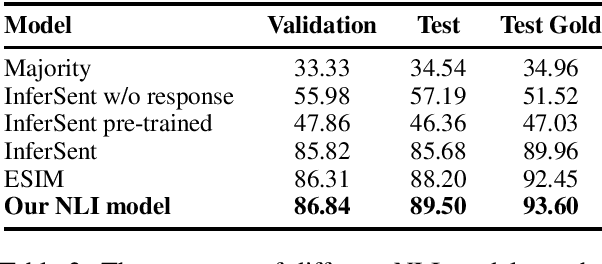
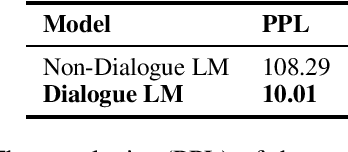

Abstract:Recent transformer-based open-domain dialogue agents are trained by reference responses in a fully supervised scenario. Such agents often display inconsistent personalities as training data potentially contain contradictory responses to identical input utterances and no persona-relevant criteria are used in their training losses. We propose a novel approach to train transformer-based dialogue agents using actor-critic reinforcement learning. We define a new reward function to assess generated responses in terms of persona consistency, topic consistency, and fluency. Our reference-agnostic reward relies only on a dialogue history and a persona defined by a list of facts. Automatic and human evaluations on the PERSONACHAT dataset show that our proposed approach increases the rate of persona-consistent responses compared with its peers that are trained in a fully supervised scenario using reference responses.
 Add to Chrome
Add to Chrome Add to Firefox
Add to Firefox Add to Edge
Add to Edge